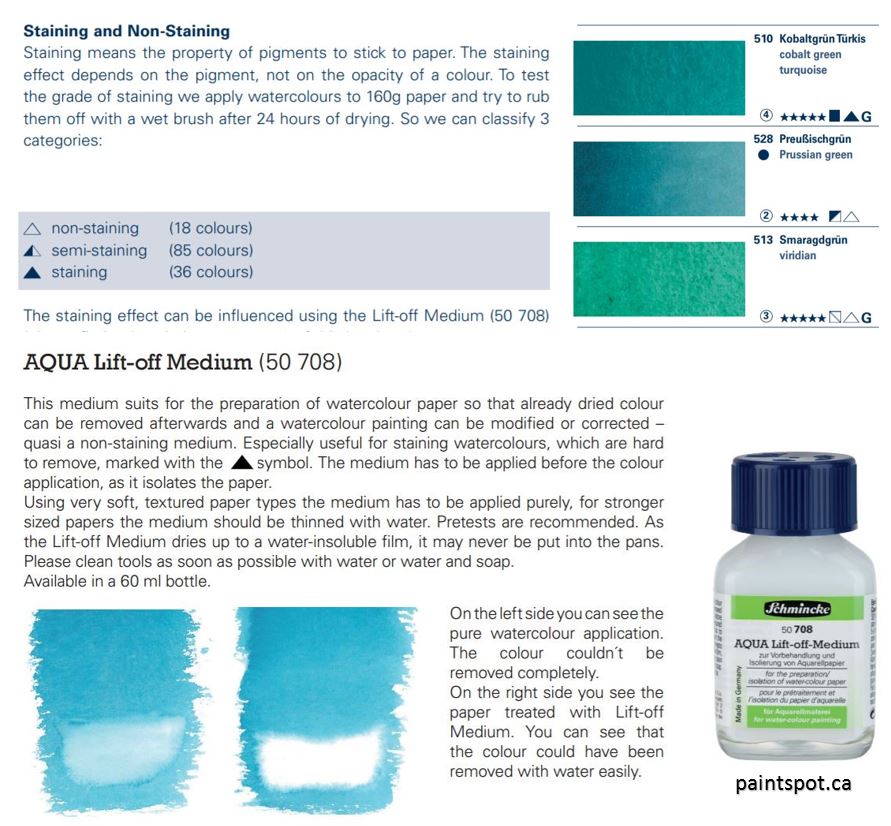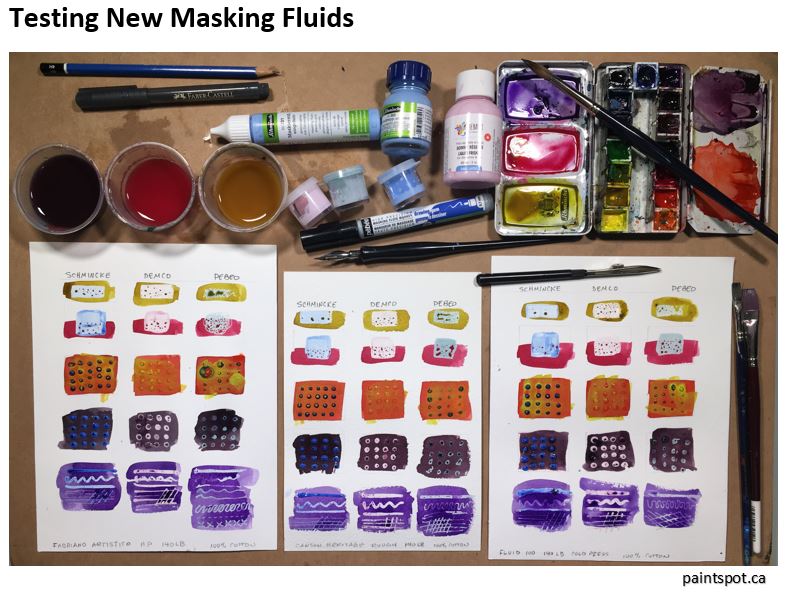Masking fluid is like latex glue. It is sometimes called ‘liquid frisket.’ It is a slightly rubbery substance that can be applied to watercolour papers to preserve the white areas that are too tiny or complex to paint around.
Why use liquid frisket
The main reasons to use masking fluid are: to protect the white of the paper; to protect the precious highlights; to protect small details, and to create crisp edges while painting smooth backgrounds like skies and water. We have used two different brands in this post. Neither Demco Masking Fluid nor Schmincke Masking Fluid contains ammonia; both are water-soluble and clean easily with a little soap and water.
Before you start
Plan your composition carefully, and try to understand the relationships between lights and darks as well as positive and negative shapes. Use light pencil lines to outline shapes to help guide the exact placement of the masking fluid. If you are using graphite transfer paper, be sure to trace lightly as dark marks are hard to erase later.
Test a small amount of masking fluid on your watercolour paper choice. Try removing this mask to see if removal will tear or mar the surface. Our tests suggest that the paper surface greatly affects the performance of the mask. Student papers are usually cellulose (wood pulp) rather than cotton. Cellulose paper is weaker and may tear more easily than cotton paper. Watercolour paper is traditionally sized with gelatin so the paint does not sink straight into the paper.
Internal sizing ensures that the paper does not become more absorbent even after scratching or scrubbing its surface. Some papers may not have enough sizing to work well with masking fluid. Lightly-sized papers are great for drawing and mixed media but are not strong enough to handle masking fluid. Handmade papers are often too lightly sized. Hot press surfaces work best, cold press surfaces work quite well, while rough papers may be tricky, because the texture of bumps and crevices provides extra surface for the mask to grab onto, making it hard to remove without harming the paper or causing it to tear.
Practice marks and brushstrokes to get a feel for the fluid. Getting the thickness of the application just right may take a few tries. Big blobs and thickly applied areas are more likely to tear the paper. The best approach to applying the masking fluid is to have a balance: apply it thick enough to cover the paper but not too thick that it takes too long to dry.
6 Golden rules for masking fluid and liquid frisket
Do not shake the bottle before use
Bubbles in the masking fluid create unpredictable, odd shapes, and when they pop leave unprotected holes. It’s better to slightly roll the container or gently rotate it to avoid bubbles.
Use only on dry surfaces
Do not use on wet or damp paper. The mask’s edges may dissolve and the fluid will sink into the paper, becoming difficult to remove. Do not paint on top of the mask that is not fully dry. It may smear or lift the colour creating an unsightly spot in the painting.
Test your paper first
Do not use on unsized drawing or printmaking papers. The fluid will bind too aggressively and will tear the paper when you try to remove it. Masking fluid is to be used on sized watercolour paper, hot press, cold press, or rough. Be careful when masking on handmade watercolour papers as they will likely prove to be too delicate and insufficiently sized.
Do not use a hair dryer to speed the drying of masking fluid or paint
The air flow may push the paint against the mask, creating a dark ring around the edges. The heat may cook the mask into the paper and make it difficult if not impossible to remove.
Do not leave masking fluid on paper for long periods of time
Remove it within a few days. Many brands of masking fluid have a latex base and will bond to the paper if left too long, becoming impossible to remove without tearing the paper.
Application tips
Masking fluid dries quickly. It is best to decant the fluid into a small container so as to use only a little at a time. Longer cap-off times may also affect the shelf life of the product. Be sure to put the lid back on immediately.
Masking fluid may have a slight colour tint, usually pink or blue, to make it easier to see on your paper. The colour will not normally stain paper unless applied while the paper is wet or rubbed into the paper before the mask has dried.
Do not put your brush or tool directly into the masking fluid container for fear of contamination.
Synthetic brushes are a popular choice and work well for applying all brands of masking fluid and frisket. It it a best practice to wash your brushes with soapy water immediately after use.
Demco Masking Fluid and Schmincke Masking Fluid are new water-based, latex-free, and ammonia-free masking fluids. They are quite forgiving; even when dry they will peel off the brush and dissolve in water. However, some brands have a strong ammonia content, and there is no solvent available to dissolve these. With these, it helps to coat your brushes with a little dish soap, wipe them dry, then dip into the mask, paint a little, rinse the brush quickly and repeat.
Tools for applying masking fluid
For extra fine details, try a calligraphy nib, Chinese bamboo pen, or a ruling pen. Test a few and see what works for you. There are many new refillable paint markers and unique application bottles available for masking fluid. Be sure to clean and replace nibs often. Pebeo and Holbein have masking applicator pens to help create fine details.
Apply the fluid directly to the dry the paper. Masking acts like a skin over those areas you want to protect from the next colour wash.
Once you have finished applying the colour, and it is fully dry, the mask may be removed with a gentle rub of your clean, dry fingers. Do not rub too hard as you may smudge your watercolour into the white areas. Check your fingers often for possible colour transfer and clean them before proceeding. In one test, we discovered it was not the masking fluid that stained the paper but the watercolour around the masked area that was smudged into the white paper by rubbing with dirty or damp fingers.
Here is an important tip. If you see puddles of watercolour dried on your mask, take a moment to use a damp paper towel or Q-tip to carefully dab or wipe off that excess colour. If you don’t, this rogue colour will definitely smear and rub into the paper creating an unsightly smudge mark.
Rubber cement pick-up
We recommend a Rubber Cement Pick-Up as a better option than your fingers for removing masking fluid. It is best to remove the mask slowly. Gentle rubbing works better than pulling it up like string.
After the mask is removed you can paint on the white areas, and add colour and details as you wish.
Apply masks several times if needed. Apply it to white paper again or painted areas, but you must ensure that everything is fully dry. Do not apply the mask to wet paint because the masking edges might bleed and fluid will bond to the paint. The layers of colour may lift with the masking and the paper may tear. Always remove the mask in a timely manner and with care.
For best results, if you are using mask on top of watercolour paint, choose staining colours. They are better than non-staining colours that may lift or smudge too easily. You can find information about the staining quality of all colours on tube labels, colour charts, and pigment identification charts. Visit The Paint Spot. We always have this information handy.
Cleaned brushes with soap and water before they dry. If you spill masking fluid, wash the affected item immediately in soapy water. Remove the latex mask by picking at it, or preferably, rubbing it with an eraser.

Check out the masking fluids The Paint Spot carries.
Bonus information
Thank you for reading this far! Your reward is more related information. Most companies have an icon to help artists understand the staining properties of their colours. Below is an example from Schmincke Horadam Watercolours. Add lifting medium to staining colours to make them easier to remove or wipe back white highlights.

_________________________________________
Kim Fjordbotten (August 2019) As the owner of The Paint Spot, Kim Fjordbotten is passionate about helping artists use materials and make art. She is available as a speaker and educator for teachers and art associations. The Paint Spot offers exhibitions, workshops, and beautiful art materials to inspire your creativity.
Notice you are not bombarded with advertising while sourcing this information. Please help us by purchasing your art supplies from The Paint Spot. We really appreciate your business and it means we can keep making educational posts for free. Thank you.


